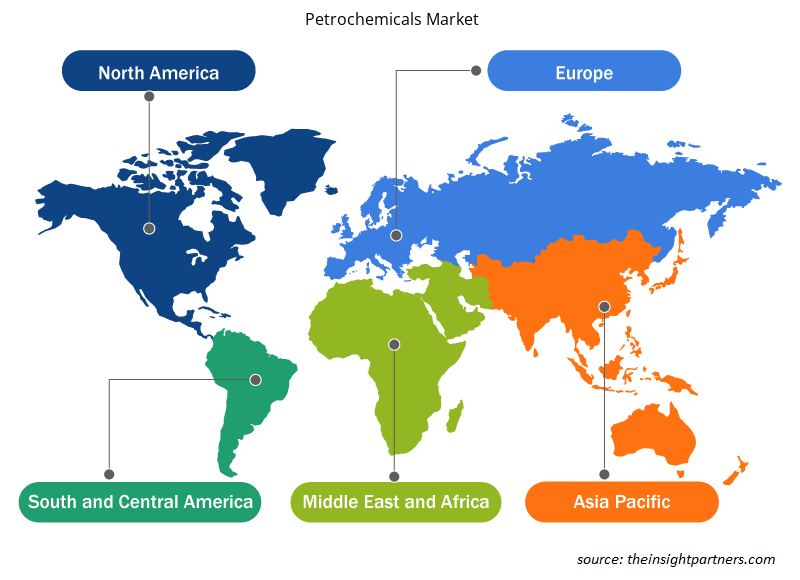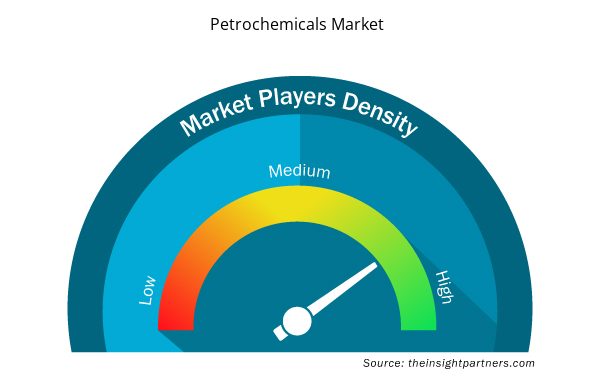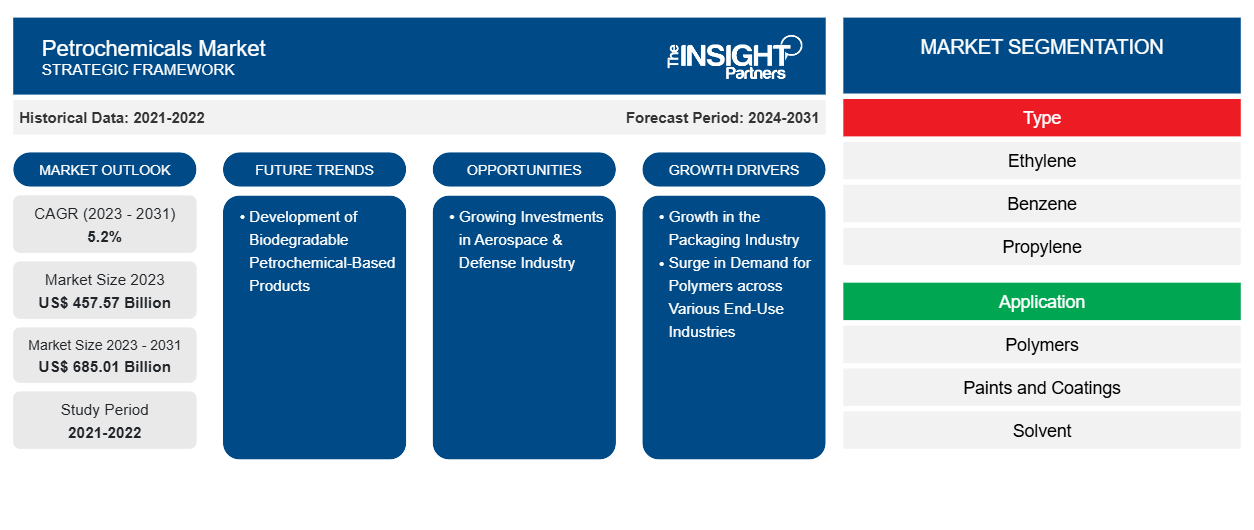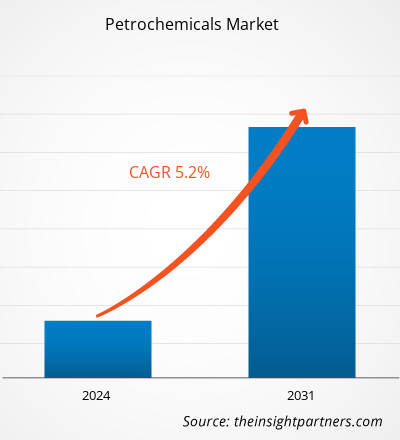预计到 2031 年,石化产品市场规模将从 2023 年的 4575.7 亿美元增至 6850.1 亿美元。预计 2023-2031 年期间市场复合年增长率为5.2%。由于对包装产品的需求不断增长,石化产品在全球范围内受到欢迎。由于制造各种聚合物都需要石化产品,因此石化产品在各个行业的应用趋势越来越明显。
石化产品市场分析
石化产品在包装解决方案中发挥着重要作用,这主要是因为它们具有多功能性、耐用性和成本效益。最常见的石化基塑料包括聚乙烯、聚丙烯、聚对苯二甲酸乙二醇酯 (PET)、聚氯乙烯和聚苯乙烯。聚乙烯因其柔韧性和防潮性而广泛用于塑料袋和薄膜包装,而 PET 则用于制造饮料瓶。此外,聚酰胺、聚丙烯、聚苯乙烯、高密度聚乙烯、热塑性弹性体、聚氨酯、聚碳酸酯和聚氯乙烯等石化基聚合物在汽车工业中得到广泛应用,因为这些聚合物具有出色的耐用性和耐腐蚀性。
石化产品市场概况
石化产品市场是全球化学工业的一个重要领域,涉及石油和天然气衍生化学品的生产和分销。这些化学品对于制造各种产品至关重要,例如包装材料、聚合物、合成纤维、工业化学品、溶剂和涂料等。石化产品市场的重要驱动因素之一是终端行业对聚合物的需求不断增长。源自石化产品的聚合物具有广泛的应用,例如包装、汽车、电子和建筑。汽车行业依靠塑料和聚合物来制造轻量化部件,以提高燃油效率并减少排放。石化生产工艺的技术进步也推动了市场的增长。
定制此报告以满足您的需求
您可以免费定制任何报告,包括本报告的部分内容、国家级分析、Excel 数据包,以及为初创企业和大学提供优惠和折扣
- 获取此报告的关键市场趋势。这个免费样品将包括数据分析,从市场趋势到估计和预测。
石化产品市场的驱动因素和机遇
各终端行业对聚合物的需求激增
聚酰胺、聚丙烯、聚苯乙烯、高密度聚乙烯、热塑性弹性体、聚氨酯、聚碳酸酯和聚氯乙烯等石油化工基聚合物广泛应用于汽车工业,因为这些聚合物具有出色的耐用性和耐腐蚀性。据 CDI Products Company 称,汽车行业是聚合物的重要消费者。这些聚合物可延长汽车零部件的使用寿命,包括内饰件和车身外板以及引擎盖下的应用。根据《2023 年欧洲塑料报告》,全球塑料产量从 2020 年的 3.804 亿吨增加到 2022 年的 4.003 亿吨。
据 CDI Products Company 称,汽车行业有各种基于石化产品的聚合物应用,包括 PTFE 密封件、O 形圈、轴承和推力轴承、低阻力挡泥板、悬架缸密封件、传感器盖、隔膜、旋转密封件、定制垫圈、线束和外壳以及压力阀的电池密封等。根据欧洲汽车制造商协会的数据,欧盟在 2023 年前三个季度登记的汽车产量超过 900 万辆,比 2022 年同期增长 14%。汽车行业对聚合物的使用日益增加,再加上汽车行业的发展,推动了对石化产品的需求。
航空航天和国防工业投资不断增长
据欧盟委员会称,欧盟于 2021 年成立了“地平线欧洲”研究和创新计划,总预算约为 1030 亿美元,也侧重于航空航天研究。由于安全风险上升和需要加强国家边境安全,各国政府增加了对航空航天相关研究的投资,包括国防和弹道防护。例如,印度国防部于 2022 年发布了一份报告,指出其目标是到 2025 年将国防生产增加到 220 亿美元。该报告还透露,政府启动了国防卓越创新和技术发展基金等举措,为武装部队的产品创新提供资金援助。在美国,由于波音公司和湾流航空航天公司等老牌飞机制造商的存在,航空业正在显着增长。加拿大的航空制造业在政府的资助下大量生产用于商业用途的飞机零部件。根据国际贸易协会的报告,加拿大政府在2021-2022年通过联邦战略创新基金向航空航天领域提供了13.6亿美元的支持。法国拥有五大飞机制造商——空中客车公司(大型商用和军用飞机、无人机和航天器)、空中客车直升机公司、达索航空公司(高端公务机、战斗机和无人机)、ATR(用于区域运输的客运和货运涡桨飞机)和达赫尔公司(TBM和Kodiak轻型飞机和商用涡桨飞机)。根据国际贸易管理局(ITA),法国拥有全方位的军事生产能力,包括战斗机、核潜艇、航空母舰和弹道导弹生产。
根据国际贸易管理局的报告,阿联酋政府已在航空航天业投资了各种举措,从而增加了市场参与者和原始设备制造商 (OEM) 之间的合作伙伴关系数量。2023 年,Markab Capital 与 Super Jet International 签署协议,投资 1.8 亿美元在阿联酋建造民用飞机制造厂。第一阶段的生产能力包括每年 10-15 架飞机。石化产品和石化衍生产品用于润滑剂、润滑脂、航空燃料和航空航天部件。因此,预计在预测期内,航空航天和国防工业投资的增加将为石化市场增长创造丰厚的机会。
石化产品市场报告细分分析
有助于得出石化产品市场分析的关键部分是类型、应用和最终用途行业。
- 根据类型,石化产品市场分为乙烯、苯、丙烯、二甲苯等。乙烯部分在 2023 年占据了最大的市场份额。
- 根据应用,市场分为聚合物、油漆和涂料、溶剂、橡胶、粘合剂、表面活性剂等。2023 年,聚合物领域占据了最大的市场份额。
就最终用途行业而言,市场细分为包装、汽车、建筑、电气和电子、医疗保健、农业、航空航天和国防等。2023 年,包装行业占据了市场主导地位。
石化产品市场份额按地区分析
石化市场报告的地理范围主要分为五个地区:北美、亚太、欧洲、中东和非洲、南美和中美。
2023 年,亚太地区主导了石化产品市场。亚太地区石化产品市场的增长得益于该地区强劲的经济发展和工业化。亚太国家处于这一市场扩张的前沿,利用其广泛的工业基础,不断增加的消费市场,并对石化基础设施进行战略投资,以增强其市场占有率。随着中国、印度和东南亚国家快速的城市化和基础设施发展导致交通网络、能源设施和公共设施等建筑活动的增加,建筑业已成为石化产品的主要消费者。在 2030 年可持续发展目标下,亚洲开发银行宣布了其计划,以建设有弹性的基础设施,促进包容性和可持续的工业化,并支持亚太地区的产品创新。
石化产品市场区域洞察
Insight Partners 的分析师已详细解释了预测期内影响石化产品市场的区域趋势和因素。本节还讨论了北美、欧洲、亚太地区、中东和非洲以及南美和中美洲的石化产品市场细分和地理位置。

- 获取石化产品市场的区域具体数据
石化产品市场报告范围
| 报告属性 | 细节 |
|---|---|
| 2023 年的市场规模 | 4575.7亿美元 |
| 2031 年市场规模 | 6850.1亿美元 |
| 全球复合年增长率(2023 - 2031) | 5.2% |
| 史料 | 2021-2022 |
| 预测期 | 2024-2031 |
| 涵盖的领域 | 按类型
|
| 覆盖地区和国家 | 北美
|
| 市场领导者和主要公司简介 |
|
石化市场参与者密度:了解其对业务动态的影响
石化产品市场正在快速增长,这得益于终端用户需求的不断增长,而这些需求又源于消费者偏好的不断变化、技术进步以及对产品优势的认识不断提高等因素。随着需求的增加,企业正在扩大其产品范围,进行创新以满足消费者的需求,并利用新兴趋势,从而进一步推动市场增长。
市场参与者密度是指在特定市场或行业内运营的企业或公司的分布情况。它表明在给定市场空间中,相对于其规模或总市场价值,有多少竞争对手(市场参与者)存在。
在石化产品市场运营的主要公司有:
- 壳牌国际有限公司
- 中国石油天然气集团公司
- 利安德巴塞尔工业控股有限公司
- 雪佛龙菲利普斯化学有限公司
- 沙特基础工业公司
- 巴斯夫
免责声明:上面列出的公司没有按照任何特定顺序排列。

- 了解石化产品市场的主要参与者概况
石化产品市场新闻及最新发展
石化产品市场评估是通过收集一手和二手研究后的定性和定量数据进行的,其中包括重要的公司出版物、协会数据和数据库。石化产品市场的一些发展情况如下:
- 壳牌德国有限公司已做出最终投资决定 (FID),将莱茵能源化工园区韦瑟林工厂的加氢裂化装置改造成 III 类基础油生产装置,用于制造高品质润滑油,如发动机油和变速箱油。韦瑟林工厂的原油加工将于 2025 年完成,但戈多夫工厂将继续进行原油加工。(来源:壳牌德国有限公司,新闻稿,2024 年 1 月)
- SABIC 与福建能源石化集团有限公司(福建能源石化)的合资企业举行了奠基仪式,标志着 SABIC 福建石化综合体(中沙古雷乙烯综合体项目)在中国福建省全面实施和建设阶段的开始。(来源:SABIC,新闻稿,2024 年 2 月)
- 巴斯夫秉承以客户为中心的企业战略,扩大了位于比利时安特卫普的 Verbund 工厂的环氧乙烷和环氧乙烷衍生物产能。(来源:巴斯夫 SE,新闻稿,2023 年 10 月)
石化产品市场报告范围及交付成果
“石化产品市场规模和预测(2021-2031 年)”报告对以下领域进行了详细的市场分析:
- 范围内涵盖的所有主要细分市场的全球、区域和国家层面的石化产品市场规模和预测
- 石化产品市场趋势以及市场动态,如驱动因素、限制因素和关键机遇
- 详细的波特五力分析和 SWOT 分析
- 石化市场分析涵盖主要市场趋势、全球和区域框架、主要参与者、法规和最新市场发展
- 行业格局和竞争分析,涵盖市场集中度、热点图分析、知名参与者以及石化市场的最新发展
- 详细的公司简介
- 行业格局和竞争分析,涵盖市场集中度、热点图分析、知名参与者和最新发展
- 详细的公司简介
- 历史分析(2 年)、基准年、预测(7 年)及复合年增长率
- PEST 和 SWOT 分析
- 市场规模价值/数量 - 全球、区域、国家
- 行业和竞争格局
- Excel 数据集



Report Coverage
Revenue forecast, Company Analysis, Industry landscape, Growth factors, and Trends

Segment Covered
This text is related
to segments covered.

Regional Scope
North America, Europe, Asia Pacific, Middle East & Africa, South & Central America

Country Scope
This text is related
to country scope.
常见问题
The major players operating in the global petrochemicals market are Shell International BV, China Petroleum Corporation, LyondellBasell Industries Holdings BV, Chevron Phillips Chemical Company LLC, SABIC, BASF SE, BP Plc, INEOS, DOW Inc, and Mitsubishi Chemical Corp.
Growing investments in the aerospace & defense industry act as a significant future opportunity for the petrochemicals market. Governments of various countries have increased investments in aerospace-related research, including defense and ballistic protection, owing to a rise in security risks and the need to enhance national border security.
Ethylene is a colorless, flammable gas that has an odor and sweet taste. Ethylene can be sourced primarily from two natural sources, including both natural gas and petroleum. It is a crucial industrial chemical derived from petrochemicals. It is produced by either heating natural gas or petroleum to 800°C–900°C, where ethylene is separated from the mixture of gases. The melting point of ethylene is −169.4°C, and its boiling point is −103.9°C.
Asia Pacific accounted for the largest share of the global petrochemicals market. The growth of the petrochemicals market in Asia Pacific is propelled by the region's robust economic development and industrialization. The abovementioned countries are at the forefront of this market expansion, leveraging their extensive industrial bases, increasing consumer markets, and making strategic investments in petrochemical infrastructure to enhance their market presence.
Polymers segment is expected to grow at the fastest CAGR during the forecast period. A few of the key petrochemicals, such as ethylene, propylene, and benzene, serve as fundamental building blocks in polymer synthesis. Ethylene is polymerized to produce polyethylene; it is a type of plastic that is used in packaging materials, containers, and household goods. Propylene is crucial for making polypropylene, valued for its strength and flexibility in applications ranging from automotive parts to textiles.
Petrochemicals play a major role in making packaging solutions, primarily due to their versatility, durability, and cost-effectiveness. The most common petrochemical-based plastics include polyethylene, polypropylene, polyethylene terephthalate (PET), polyvinyl chloride, and polystyrene. Polyethylene is widely used in plastic bags and film wraps due to its flexibility and moisture resistance, while PET is utilized in manufacturing beverage bottles.
Trends and growth analysis reports related to Chemicals and Materials : READ MORE..
The List of Companies - Petrochemicals Market
- BASF SE
- BP Plc
- Chevron Phillips Chemical Company LLC
- China Petroleum Corporation
- DOW Inc
- INEOS
- LyondellBasell Industries Holdings BV
- Mitsubishi Chemical Corp.
- SABIC
- Shell International BV
The Insight Partners performs research in 4 major stages: Data Collection & Secondary Research, Primary Research, Data Analysis and Data Triangulation & Final Review.
- Data Collection and Secondary Research:
As a market research and consulting firm operating from a decade, we have published and advised several client across the globe. First step for any study will start with an assessment of currently available data and insights from existing reports. Further, historical and current market information is collected from Investor Presentations, Annual Reports, SEC Filings, etc., and other information related to company’s performance and market positioning are gathered from Paid Databases (Factiva, Hoovers, and Reuters) and various other publications available in public domain.
Several associations trade associates, technical forums, institutes, societies and organization are accessed to gain technical as well as market related insights through their publications such as research papers, blogs and press releases related to the studies are referred to get cues about the market. Further, white papers, journals, magazines, and other news articles published in last 3 years are scrutinized and analyzed to understand the current market trends.
- Primary Research:
The primarily interview analysis comprise of data obtained from industry participants interview and answers to survey questions gathered by in-house primary team.
For primary research, interviews are conducted with industry experts/CEOs/Marketing Managers/VPs/Subject Matter Experts from both demand and supply side to get a 360-degree view of the market. The primary team conducts several interviews based on the complexity of the markets to understand the various market trends and dynamics which makes research more credible and precise.
A typical research interview fulfils the following functions:
- Provides first-hand information on the market size, market trends, growth trends, competitive landscape, and outlook
- Validates and strengthens in-house secondary research findings
- Develops the analysis team’s expertise and market understanding
Primary research involves email interactions and telephone interviews for each market, category, segment, and sub-segment across geographies. The participants who typically take part in such a process include, but are not limited to:
- Industry participants: VPs, business development managers, market intelligence managers and national sales managers
- Outside experts: Valuation experts, research analysts and key opinion leaders specializing in the electronics and semiconductor industry.
Below is the breakup of our primary respondents by company, designation, and region:

Once we receive the confirmation from primary research sources or primary respondents, we finalize the base year market estimation and forecast the data as per the macroeconomic and microeconomic factors assessed during data collection.
- Data Analysis:
Once data is validated through both secondary as well as primary respondents, we finalize the market estimations by hypothesis formulation and factor analysis at regional and country level.
- Macro-Economic Factor Analysis:
We analyse macroeconomic indicators such the gross domestic product (GDP), increase in the demand for goods and services across industries, technological advancement, regional economic growth, governmental policies, the influence of COVID-19, PEST analysis, and other aspects. This analysis aids in setting benchmarks for various nations/regions and approximating market splits. Additionally, the general trend of the aforementioned components aid in determining the market's development possibilities.
- Country Level Data:
Various factors that are especially aligned to the country are taken into account to determine the market size for a certain area and country, including the presence of vendors, such as headquarters and offices, the country's GDP, demand patterns, and industry growth. To comprehend the market dynamics for the nation, a number of growth variables, inhibitors, application areas, and current market trends are researched. The aforementioned elements aid in determining the country's overall market's growth potential.
- Company Profile:
The “Table of Contents” is formulated by listing and analyzing more than 25 - 30 companies operating in the market ecosystem across geographies. However, we profile only 10 companies as a standard practice in our syndicate reports. These 10 companies comprise leading, emerging, and regional players. Nonetheless, our analysis is not restricted to the 10 listed companies, we also analyze other companies present in the market to develop a holistic view and understand the prevailing trends. The “Company Profiles” section in the report covers key facts, business description, products & services, financial information, SWOT analysis, and key developments. The financial information presented is extracted from the annual reports and official documents of the publicly listed companies. Upon collecting the information for the sections of respective companies, we verify them via various primary sources and then compile the data in respective company profiles. The company level information helps us in deriving the base number as well as in forecasting the market size.
- Developing Base Number:
Aggregation of sales statistics (2020-2022) and macro-economic factor, and other secondary and primary research insights are utilized to arrive at base number and related market shares for 2022. The data gaps are identified in this step and relevant market data is analyzed, collected from paid primary interviews or databases. On finalizing the base year market size, forecasts are developed on the basis of macro-economic, industry and market growth factors and company level analysis.
- Data Triangulation and Final Review:
The market findings and base year market size calculations are validated from supply as well as demand side. Demand side validations are based on macro-economic factor analysis and benchmarks for respective regions and countries. In case of supply side validations, revenues of major companies are estimated (in case not available) based on industry benchmark, approximate number of employees, product portfolio, and primary interviews revenues are gathered. Further revenue from target product/service segment is assessed to avoid overshooting of market statistics. In case of heavy deviations between supply and demand side values, all thes steps are repeated to achieve synchronization.
We follow an iterative model, wherein we share our research findings with Subject Matter Experts (SME’s) and Key Opinion Leaders (KOLs) until consensus view of the market is not formulated – this model negates any drastic deviation in the opinions of experts. Only validated and universally acceptable research findings are quoted in our reports.
We have important check points that we use to validate our research findings – which we call – data triangulation, where we validate the information, we generate from secondary sources with primary interviews and then we re-validate with our internal data bases and Subject matter experts. This comprehensive model enables us to deliver high quality, reliable data in shortest possible time.


 获取此报告的免费样本
获取此报告的免费样本